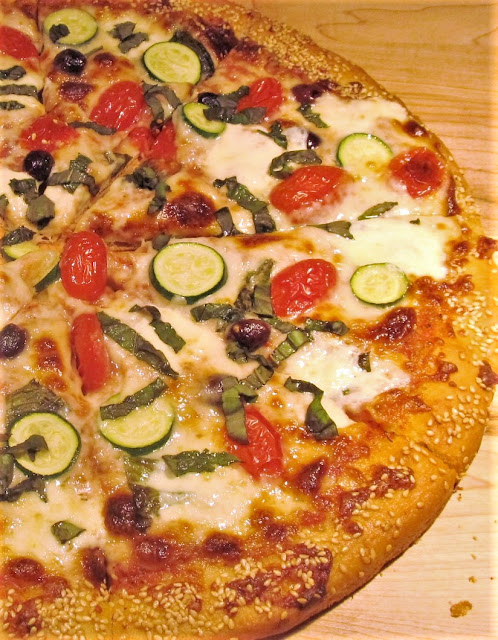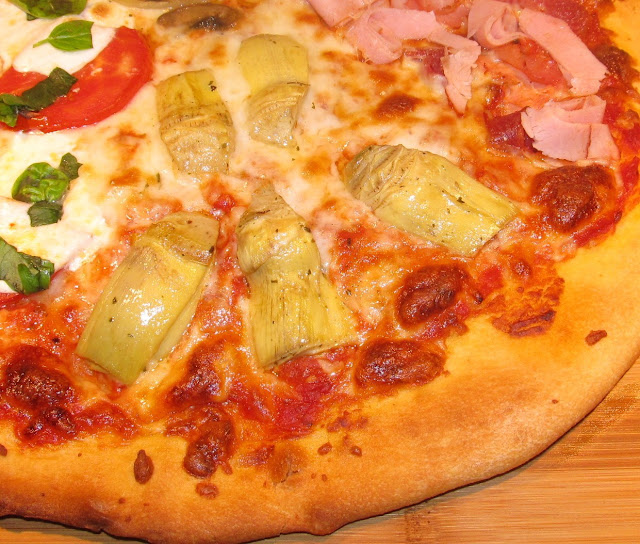Wish I had one slice left. Even half a slice. I would settle for half of a slice. Unfortunately, it's all gone and I am left only with pictures and memories. Ah, the taste memories! I am eulogizing this pizza because it's not store bought, I made it myself. Made the dough, arranged the toppings, even used zucchini from my garden, and handpicked the basil leaves from the plant that grows on my patio. So I had special feelings about this pizza. We had a relationship. It's over now. The pizza has been eaten.
What can I say? I'm Greek and Greeks love bread! I would wager it's every Greek's favourite thing to eat. So just about any Greek who cooks knows how to bake bread with homemade dough. And they all like to argue about whose dough is the best.
Another important thing in pizza making is to have a flavourful sauce. Not a bland unseasoned sauce, nor a strong over-seasoned one, not a runny sauce, and not an extra thick and heavy sauce. Pretend you are a politician who has to tread in the middle of the political spectrum, then make your pizza sauce accordingly. But you will not have created a middle of the road sauce, instead, you will have a balanced sauce!
I'll tell you how I make my pizza; the recipe is tied and true and it makes an amazing pizza!
Ingredients:
4 cups bread flour
1½ cups very cold water
¼ cup smooth extra virgin olive oil
1 teaspoon salt
2 teaspoons sugar
2 teaspoons instant yeast
a little more flour, cold water and oil
Directions:
- In the bowl of an electric mixer add the water, salt, sugar, oil and yeast. Using the paddle attachment, mix until the ingredients are incorporated.
- Switch to the dough hook and add the flour in 8 batches (1/2 cup increments), mixing after each addition. Mix until the dough is smooth and clears the sides of the bowl.
- Be patient and let it mix, but if it looks as though it's going to stay a little too wet, sprinkle more flour into the bowl and mix until done. If the dough starts to wrap itself around the dough hook and looks as though it’s heading out of the bowl, add some water. You want a dough that is soft and just a little sticky.
- Sprinkle flour on your work counter and place the dough on top.
- Line a sheet pan with parchment paper and lightly oil the parchment.
- Cut the dough into pieces and weigh it: 14 to 16 ounces/400+ grams are good for a large pizza that will serve about 4 people, and 8 to 10 ounces/230+ grams are good for a smaller one that will serve about 2 people.
- Form each piece of dough into a round and place it on the sheet pan.
- Cover the dough with flour and then cover the pan it's on with a plastic bag. Make sure it's well covered.
- Place the pan in the refrigerator. It should stay there to rest overnight.
- Any dough that will not be used the next day can be individually wrapped in plastic, placed in a freezer bag and frozen. It can be kept in the freezer for 2 to 3 months.
To make a pizza:
- Place a dough ball on the counter. If frozen, let it come to room temperature. Cover it with flour and flatten it with the palm of your hand. Let it rest for 20 minutes and then flatten it to the appropriate size by using a rolling pin.
- I don't like to bake my pizza directly on top of a pizza stone. I use a pizza pan, and I place the pan on the pizza stone. So at this point, I place the dough in its pan and I stretch it with floured hands until it has reached the sides of the pan. If the dough shrinks back from the sides, let it rest for a few minutes and it will become pliable and stay put and do what you want it to do.
- I use a pan with a 14-inch diameter for a large pizza and a pan with a 10-inch diameter for a small pizza.
- Once the dough is stretched out in the pan, it's time to spread on the sauce. Two tablespoons of sauce for the small pizza, or four tablespoons of sauce for the large one. After that, I sprinkle on the cheese.
- At this point, the dough has to rest again so that it can rise. Cover it with plastic and let it rise for about 2 hours. If the pizza will not be cooked after the 2 hours, it can wait in the refrigerator.
- When ready to cook add any toppings that will be used. The oven should be preheated to 450ºF/230ºC. Place the pizza in the oven, on top of the pizza stone. Baking time will be approximately 8 minutes.
- If the top cooks before the bottom, next time move the pizza stone to a lower shelf. If the bottom is nice and crisp before the cheese and toppings are browned, then next time the stone should be placed on a shelf that sits higher in the oven.
- Always check: before starting to bake the pizza make sure the oven is nice and hot.
 |
| Ready! |
- Take the pizza out of the oven and with the use of a long knife or spatula transfer it to a cutting board. Don’t slice it yet. Inhale all the different aromas arising from it! You will smell the freshly baked dough, the melted cheese, the fragrance of roasted vegetables if any have been used. You will feel the heat rising up from the pizza, and the heat will spin all those fragrances around the room. Then look at all the lovely colours. Admire the golden dough, the redness of the sauce ... is it any wonder pizza is the world’s favourite food? Is there anyone who does not love pizza?
- Okay, now it’s time to stop admiring. Your pizza, she is ready to be eaten! It needed a few minutes of admiration so that its beauty could be thoroughly appreciated, but also so that the cheese could slightly set, becoming easier to slice. Well, what are you waiting for? Slice that baby and… you know what to do after it's sliced, don't you? Don't you?

































.JPG)








